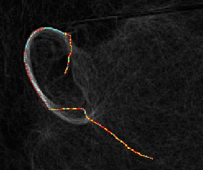Ears
The potential of the human ear for personal identification was recognized and advocated as long ago as 1890 by the French criminologist Alphonse Bertillon. In his seminal work on biometrics he writes:
Ear biometrics has received scant attention compared to the more popular techniques of automatic face, eye, or fingerprint recognition. However, ears have played a significant role in forensic science for many years, especially in the United St ates, where an ear classification system based on manual measurements was developed by Iannarelli, and has been in use for more than 40 years, although the safety of ear-print evidence has recently been challenged. Rutty et al. have considered how Iannarelli's manual techniques might be automated and a European initiative has looked at the value of ear prints in forensics.
ates, where an ear classification system based on manual measurements was developed by Iannarelli, and has been in use for more than 40 years, although the safety of ear-print evidence has recently been challenged. Rutty et al. have considered how Iannarelli's manual techniques might be automated and a European initiative has looked at the value of ear prints in forensics.
Ears have certain advantages over the more established biometrics; as Bertillon pointed out, they have a rich and stable structure that changes little with age. The ear does not suffer from changes in facial expression, and is firmly fixed in the middle of the side of the head so that the immediate background is predictable, whereas face recognition usually requires the face to be captured against a controlled background. Collection does not have an associated hygiene issue, as may be the case with contact biometrics, and is unlikely to cause anxiety as may happen with iris and retina measurements.
The ear is large compared with the iris, retina, and fingerprint and therefore is more easily captured at a distance.
"The Ear as a Biometric" D. J. Hurley, B. Arbab-Zavar and M. S. Nixon
The error rates for ear biometrics are significantly worse than DNA, fingerprint, iris, retina with a recent study producing a FAR of 8.6% and FRR of 9.3% for good images.
More at:
A Skin-Color and Template Based Technique for Automatic Ear Detection
Advances in Ear Biometrics
Biometric Recognition Using 3D Ear Shape
Comparison and Combination of Ear and Face Images in Appearance-Based Biometrics
Ear Biometrics in Human Identification dissertation
Ear biometrics for human identification
Ear biometrics may beat face recognition
Empirical Evaluation of Ear Biometrics
Feature Level Fusion in Biometric Systems
Multi-Biometric Approaches to Ear Biometrics and Soft Biometrics
P. Yan, K.W. Bowyer, A fast algorithm for ICP-based 3D shape biometrics, Comput. Vis. Image Understant. (2007), doi:10.1016/j.cviu.2006.11.001
Person Identification Using Ear Biometrics
The Ear as a Biometric
The potential of the human ear for personal identification was recognized and advocated as long ago as 1890 by the French criminologist Alphonse Bertillon. In his seminal work on biometrics he writes:
"The ear, thanks to these multiple small valleys and hills which furrow across it, is the most significant factor from the point of view of identification. Immutable in its form since birth, resistant to the influences of environment and education, this organ remains, during the entire life, like the intangible legacy of heredity and of the intra-uterine life".
Ear biometrics has received scant attention compared to the more popular techniques of automatic face, eye, or fingerprint recognition. However, ears have played a significant role in forensic science for many years, especially in the United St

Ears have certain advantages over the more established biometrics; as Bertillon pointed out, they have a rich and stable structure that changes little with age. The ear does not suffer from changes in facial expression, and is firmly fixed in the middle of the side of the head so that the immediate background is predictable, whereas face recognition usually requires the face to be captured against a controlled background. Collection does not have an associated hygiene issue, as may be the case with contact biometrics, and is unlikely to cause anxiety as may happen with iris and retina measurements.
The ear is large compared with the iris, retina, and fingerprint and therefore is more easily captured at a distance.
"The Ear as a Biometric" D. J. Hurley, B. Arbab-Zavar and M. S. Nixon
The error rates for ear biometrics are significantly worse than DNA, fingerprint, iris, retina with a recent study producing a FAR of 8.6% and FRR of 9.3% for good images.
More at:
A Skin-Color and Template Based Technique for Automatic Ear Detection
Advances in Ear Biometrics
Biometric Recognition Using 3D Ear Shape
Comparison and Combination of Ear and Face Images in Appearance-Based Biometrics
Ear Biometrics in Human Identification dissertation
Ear biometrics for human identification
Ear biometrics may beat face recognition
Empirical Evaluation of Ear Biometrics
Feature Level Fusion in Biometric Systems
Multi-Biometric Approaches to Ear Biometrics and Soft Biometrics
P. Yan, K.W. Bowyer, A fast algorithm for ICP-based 3D shape biometrics, Comput. Vis. Image Understant. (2007), doi:10.1016/j.cviu.2006.11.001
Person Identification Using Ear Biometrics
The Ear as a Biometric